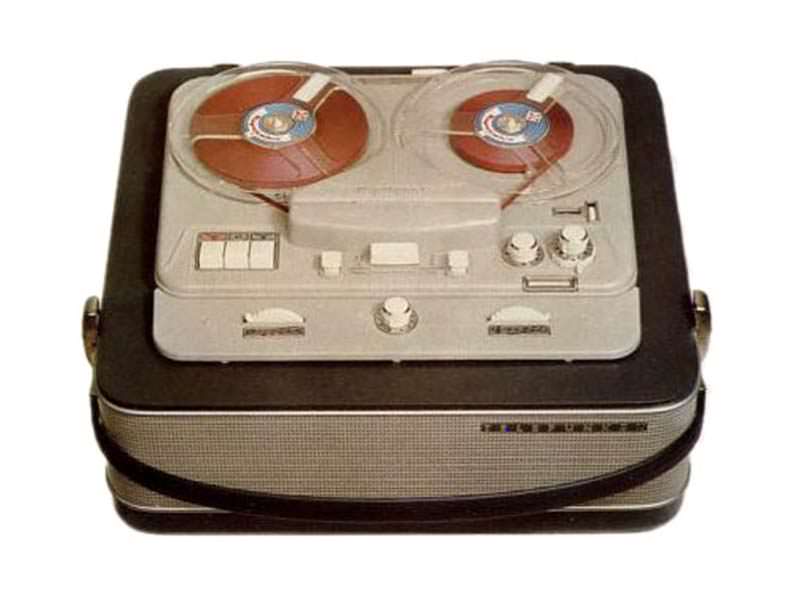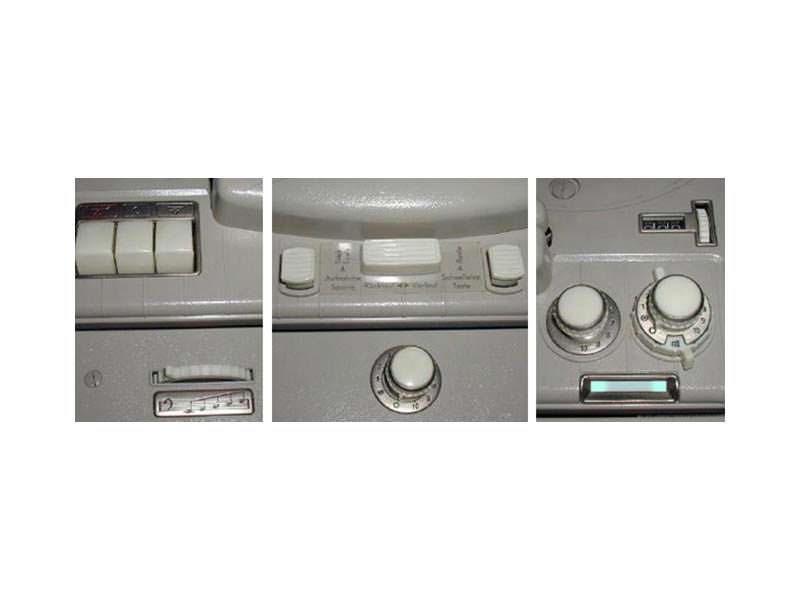Technical Details
Brand: Telefunken
Model:Magnetophon 85 De-Luxe
Category:Vintage
Application:Consumer
Electronics:Tube
Equalization:IEC
Country of Manufacture:Germany
Release dates:1963 - 1966
Tracks:1/4 Rec/PB
Speeds: 3 3/4, 7 1/2
Max Reel Size("): 7"
Number of heads: 2
Head Composition: Permalloy
Head Configuration: Mono - Full Track
Voltage(s): 220-240v
Outputs: DIN
Frequency Response:(all 3 dB): 7½ ips: 30Hz - 18kHz
Wow and Flutter:equal to or less than 0.2% at 7½ ips, 0.4% at 3¾ ips
Signal-to-Noise Ratio:Unweighted over 50 db (300:1) below normal operating level
Sound quality rating:5 / 10
Long-term reliability rating: 5/ 10
Additional Details
Description
The Magnetophon 85 De-Luxe was the last of Telefunken’s popular 85 series. This version was very similar to its older counterpart , the major changes being the output stage (6 watts of push-pull from two EL95 tubes), the colour scheme and the substitution of an EM84 ribbon-type magic eye for the older round EM71.
Total harmonic distortion: at playback output: below 5% / Valve complement: EF 86, ECC 81, ECC 83, EM84. Power stage: ECC 83 & 2 x EL95 / Rewind speed: 180 seconds approx. for 1800 ft tape / Audio output power: 85K – 3 watts, 85KL – 6 watts push-pull / Speaker(s): two PM Allvox speakers (85K and 85KL only) / Inputs: Microphone – 2 mV / 2 Mohm R adio – 2 mV / 100 Kohm Pick-up – 2 mV / 2 Mohm / Outputs: R adio – 1.5 mV / 18 Kohm Headphone monitoring – 5V External speaker – 6 watts at 15 ohms / Dimensions: 18¼ x 17 x 8½” (464 x 432 x 216 mm) / Weight: 33 lbs (15 kg) / quarter-track mono (stereo versions available)
Additional Info
From The Gramophone, , July 1963, by Geoffrey Horn
This report is no more than an attempt to bring the reader up to date on a machine which has already been quite a landmark in domestic tape recorders.
It was in the autumn of 1958 that the Technical Editor received a letter enclosing the specification of the Telefunken 85 and asking if we would like to put it through our tests as it might interest music-lovers and quality enthusiasts. Included quite modestly in the specification was the frequency response 30-20,000 c/s. In 1958 such a claim was revolutionary and our report in the December issue was able to confirm that claim. I used one myself for several years and still play some tapes made in that period. Only the need for a stereo machine dislodged it with regret from personal continuing use although to this day it remains a firm favourite for mono purposes. Now along comes this latest version, which will, I am sure, keep the series in the public eye for some years, more. Strangely enough, the frequency response claimed in the specification is no longer quite so wide; perhaps the need to stress this aspect has passed but the machine I have been using for some little time has very much the same performance as the original and so, although I have run through all the usual tests, there is little point in quoting new figures. Let me just say that this is certainly a machine which is capable of storing and repeating any signal supplied to it in a manner which defies one to say, “Ah, a tape”. And quite often it will do this at 3¾ ips if the programme material is not too demanding.
Where, then, does the “de-luxe” version differ from the original? Most obviously in appearance. Two-tone grey throughout, with satin chrome metal parts, a more squared-up line to the case and a long carrying strap, all these have completely eradicated the previous rather feminine look and replaced it, at any rate to our eyes, with something more attractive, more serviceable, more likely to be accepted for what it is, an instrument of quality. The latest ribbon-type recording level indicator is fitted in an aperture angled to be visible both from above and forward. The place previously occupied by the old circular indicator is now filled by a second recording gain control giving an independent adjustment of signals fed into the pickup input socket. Thus the signal selected y the normal control from radio, microphone or other source can be mixed with a second: this is often a very useful facility capable of giving a rather more polished blend than the usual superimpose arrangement (although this is still possible).
The amplifier now has a push-pull EL95 out- put stage feeding 6 watts into the two loud speakers and the external speaker socket (which can optionally cut out the internal units) is now of standard 15 ohms impedance. So, although in its fifth year, this is still a machine very much at the top of the mono tree, a position it shares with at least one more old favourite which has recently had a face-lift. A minor blemish which ought to be removed is the instruction booklet, never a model of its kind, which has now acquired seven odd sheets of additions and amendments – and even then the only one referring to the new mixing facilities was in Spanish!



